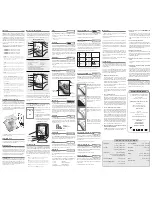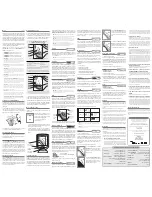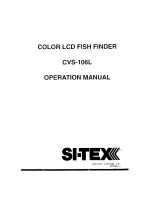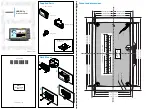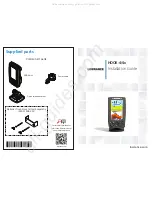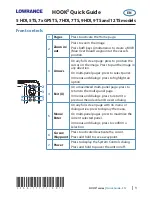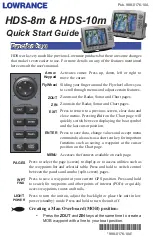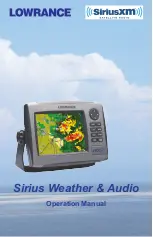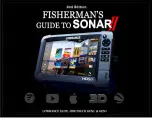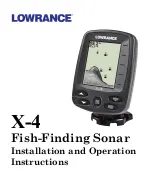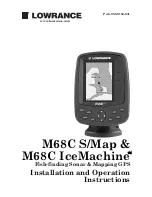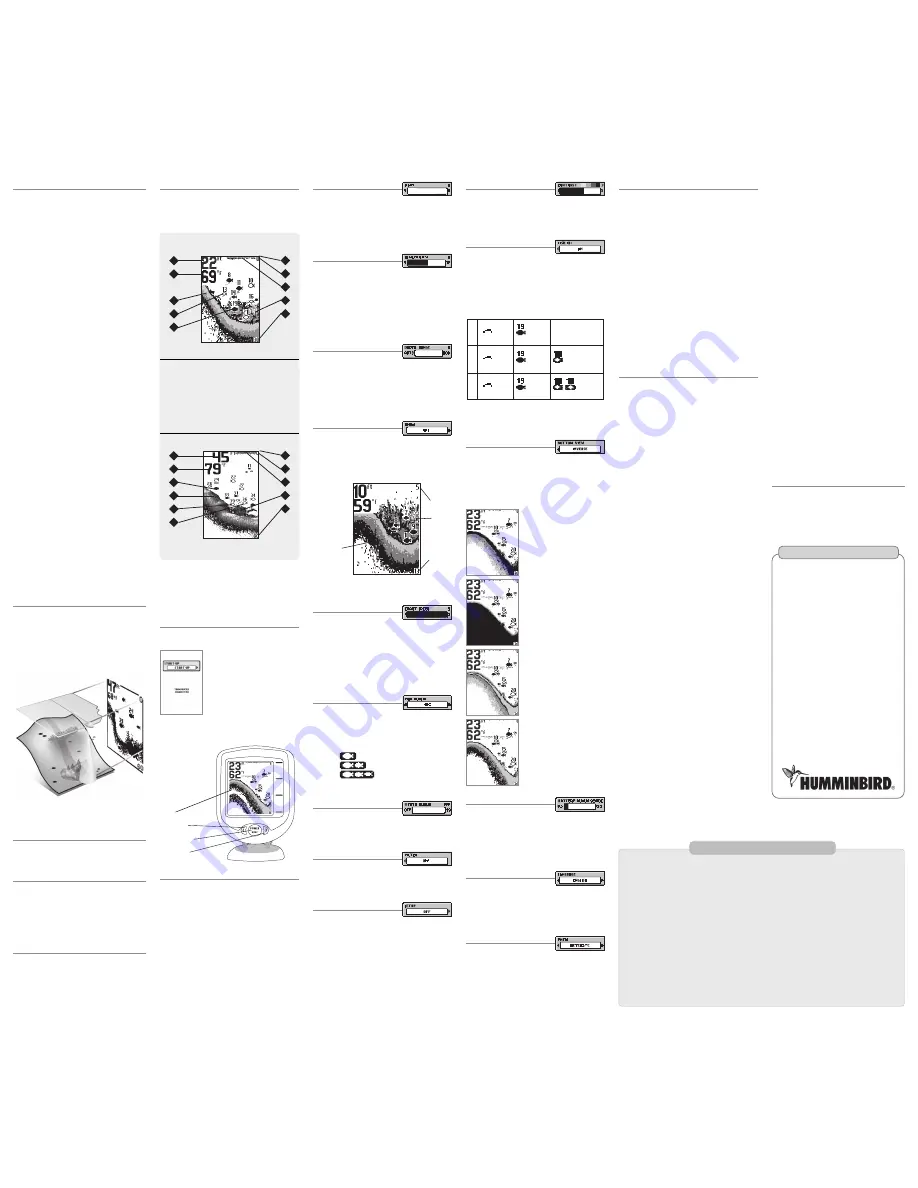
Light
(Setting Not Saved in Memory)
Press the POWER-MENU key until LIGHT appears. Use the backlight for night fishing.
Select either 0 (Off), or 1 through 5 to activate the backlight at the desired level.
(0 to 5, Default = 0)
NOTE:
Continuous backlight operation will significantly decrease the battery life for
PiranhaMax® Portables.
Sensitivity
(Setting Saved in Memory)
Press the POWER-MENU key until SENSITIVITY appears. Sensitivity controls how much
detail is shown on the display. Increasing the sensitivity shows more sonar returns from
small baitfish and suspended debris in the water; however, the display may become too
cluttered. When operating in very clear water or greater depths, increased sensitivity
shows weaker returns that may be of interest. Decreasing the sensitivity eliminates the
clutter from the display that is sometimes present in murky or muddy water. If
Sensitivity is adjusted too low, the display may not show many sonar returns that could
be fish. (0 – 10, Default = 5)
Depth Range
(Setting Not Saved in Memory)
Press the POWER-MENU key until DEPTH RANGE appears. Automatic is the default setting.
When in automatic, the lower range will be adjusted by the unit to follow the bottom. (Auto,
15 to 600 ft [PiranhaMax®210 and 215], 15 to 800 ft [PiranhaMax®220 and 240],
Default = Auto)
NOTE:
In manual operation, if the depth is greater than the depth range setting, the bottom will
not be visible on the display. Select AUTO to return to automatic operation.
Zoom
(Setting Not Saved in Memory)
Press the POWER-MENU key until ZOOM appears. Select Auto to magnify the area around
the bottom in order to reveal fish and structure close to the bottom that may not be visible
during normal operation. When ZOOM is set to Auto, the upper and lower Depth Ranges
are automatically adjusted to keep the area above and below the bottom on the display.
Select Off to return to normal operation. (Off, Auto, Manual Ranges, Default = Off)
There is also a series of manual ranges which can be selected. The manual depth
ranges are determined by the present depth conditions.
Chart Speed
(Setting Saved in Memory)
Press the POWER-MENU key until CHART SPEED appears. Select a setting from 1-5 to
increase or decrease the chart speed, where 1 is the slowest and 5 is the fastest chart
speed. Chart speed determines the speed at which the sonar information moves across
the display, and consequently the amount of detail shown. A faster speed shows more
information and is preferred by most anglers; however, the sonar information moves
across the display quickly. A slower speed keeps the information on the display longer,
but the bottom and fish details become compressed and may be difficult to interpret.
(1 to 5, Default = 5)
Fish Alarm
(Setting Saved in Memory)
Press the POWER-MENU key until FISH ALARM appears. Select Off for no fish alarm,
or one of the following symbols to set the alarm. An alarm will sound when the
PiranhaMax® detects fish that correspond to the alarm setting. Fish Alarm will only
sound if Fish ID+ is also set to On.
(Off, Large, Large/Medium, All, Default = Off)
Depth Alarm
(Setting Not Saved in Memory)
Press the POWER-MENU key until DEPTH ALARM appears. Select OFF for no Depth
Alarm, or select 3 to 99 feet to set the alarm depth. An audible alarm sounds when the
depth is equal to or less than the setting. (Off, 3 to 99 feet, Default = Off)
Filter
(Setting Saved in Memory)
Press the POWER-MENU key until FILTER appears. Select either Off or On. Filter adjusts
the sonar filter to limit interference on the display from sources such as your boat
engine, turbulence, or other sonar devices. (On, Off, Default = Off)
SetUp Menu
(Setting Not Saved in Memory)
Press the POWER-MENU key until SetUp appears. Select either Off or On. (Off, On,
Default = Off)
When you choose SetUp, additional menu choices will become available that are not a
part of the Main Menu system. After selecting SetUp, press the POWER-MENU key to
display the SetUp menu choices, one at a time. SetUp Menu choices include:
• Contrast
• Battery Alarm
• Fish ID+
TM
• Language (International only)
• Bottom View
• Units (International only).
Scroll through all SetUp menu choices to exit the SetUp menu.
Large
fish only
Large/Medium
fish only
All
fish
Thank You!
Thank you for choosing Humminbird®, America's #1 name in fishfinders.
Humminbird® has built its reputation by designing and manufacturing top-
quality,thoroughly reliable marine equipment. Your Humminbird® is designed for
trouble-free use in even the harshest marine environment. In the unlikely event that
your Humminbird® does require repairs, we offer an exclusive Service Policy-free
of charge during the first year after purchase,and available at a reasonable rate
after the one-year period. For complete details, see the separate warranty card
included with your unit. We encourage you to read this operations manual carefully
in order to get full benefit from all the features and applications of your
Humminbird® product.
Contact our Customer Resource Center at
1-800-633-1468
or visit our website
at
www.humminbird.com.
The PiranhaMax® comes in four models:
• PiranhaMAX®210
- Single Beam, 160 V x 132 H Display
•
PiranhaMAX®215
- Dual Beam, 160 V x 132 H Display
•
PiranhaMAX®220
- Dual Beam, 240 V x 160 H Display
• PiranhaMAX®240
- Tri Beam, 240 V x 160 H Display.
WARNING!
This device should not be used as a navigational aid to prevent collision,
grounding, boat damage, or personal injury. When the boat is moving, water depth may
change too quickly to allow time for you to react. Always operate the boat at very slow
speeds if you suspect shallow water or submerged objects.
CAUTION:
Do not handle the bottom of the transducer while it is transmitting sonar.
Prolonged contact with the transducer element can cause physical discomfort or minor tissue
damage.
WARNING!
Disassembly and repair of this electronic unit should only be performed by
authorized service personnel. Any modification of the serial number or attempt to repair the
original equipment or accessories by unauthorized individuals will void the warranty.
Handling and/or opening this unit may result in exposure to lead, in the form of solder.
WARNING!
This product contains lead, a chemical known to the state of California to
cause cancer, birth defects and other reproductive harm.
POLICY ON ENVIRONMENTAL COMPLIANCE:
It is the intention of
Humminbird® to be a good corporate citizen and comply and meet all known and applicable
environmental regulations in the areas and countries where our products are sold. We will
promote and implement environmentally sound processes in support of national and
international regulations.
ROHS STATEMENT:
Product designed and intended as a fixed installation or part of a
system in a vessel may be considered beyond the scope of Directive 2002/95/EC of the
European Parliament and of the Council of 27 January 2003 on the restriction of the use of
certain hazardous substances in electrical and electronic equipment.
WEEE STATEMENT:
Product designed and intended as a fixed installation or part of a
system in a vessel may be considered beyond the scope of Directive 2002/96/EC of the
European Parliament and of the Council of 27 January 2003 on waste electrical and
electronic equipment (WEEE).
CALIFORNIA PROPOSITION 65 STATEMENT:
Lead in cable jackets and boots is
restricted to 300 parts per million or less as determined by ICP-AES test methods.
PiranhaMax® Sonar Technology
The PiranhaMax® is the easiest to use fishfinder ever. For most anglers, all you’ll
ever need to do is power on and fish! The PiranhaMax® automatically determines
depth and makes adjustments to keep the bottom and fish visible on the display.
The PiranhaMax® uses sonar technology to send sound waves from the transducer
into the water. The returned “echoes” are plotted on the display, creating a very
accurate picture of the underwater world, including distance to underwater objects
such as the bottom, fish and structure.
Your PiranhaMax® will have Single, Dual or Tri Beam sonar. Find the correct sonar
description that applies to your unit.
Single Beam Sonar
Your
PiranhaMax®210
uses a 200 kHz single beam sonar system with a 20°
area of coverage. Boat speed, wave action, bottom hardness, water conditions and
transducer installation can all affect depth capability.
Dual Beam Sonar
Your
PiranhaMax®215
or
PiranhaMax®220
uses a 200/83 kHz dual beam
sonar system with a wide (60°) area of coverage. Dual Beam sonar is optimized
to show the greatest bottom definition using a narrow (20°) beam yet can still
indicate fish found in the wide (60°) beam when the Fish ID+
TM
feature is turned
on. Dual Beam is ideal for a wide range of conditions - from shallow to very deep
water in both fresh and salt water. Boat speed, wave action, bottom hardness,
water conditions and transducer installation can all affect depth capability.
Tri Beam Sonar
Your
PiranhaMax®240
uses two frequencies and three different sonar
elements, one narrow, two wide, that transmit signals to the left, right and straight
down from your boat. The downward beam is 200 kHz with a 20° area of
coverage. This beam maintains a continuous digital depth readout from the bottom
directly beneath your boat. The side beams are 455 kHz with a 35° area of
coverage, for a total 90° area of coverage.
What You See On the Display
The PiranhaMax® displays underwater information in an easy-to-understand format.
The top of the display corresponds to the water surface at the transducer, and the
bottom of the display corresponds to the Depth Range automatically selected for the
current water depth. The Bottom Contour varies as the depth under the boat changes.
Digital readouts provide precise information for depth, fish and water temperature.
As the boat moves, terrain and bottom composition variations are displayed. Fish,
baitfish and thermoclines (underwater temperature changes) are displayed when
detected. Underwater conditions vary greatly, so some experience and interpretation is
needed to realize all the benefits of the PiranhaMax® – use the picture above as a
guide to the most common conditions and practice using your PiranhaMax® over known
bottom types.
Powering ON and OFF
Press and release the POWER-MENU key to power the PiranhaMax® on. Press and
hold the POWER-MENU key until the unit shuts down to power off.
When the PiranhaMax® powers on, the Start-Up menu
temporarily appears. From this menu, select either Start-
Up, Simulator, or SetUp.
• Use Start-Up for on the water use.
• Use Simulator for learning how to use the system with
simulated sonar data; access Simulator by pressing
the Right Arrow Key once.
• Use SetUp to display additional set-up menu choices;
access SetUp by pressing the Right Arrow Key twice
(See
SetUp Menu
for more information).
The Menu System
A simple menu system allows you to access your PiranhaMax® adjustable settings. To
activate the menu system, press the POWER-MENU key. Press the POWER-MENU key
repeatedly to display the PiranhaMax® menu settings, one at a time. When a menu
setting is on the display, use the RIGHT and LEFT Arrow keys to adjust the menu setting.
Menus settings are removed from the screen automatically after several seconds. In
Normal operating mode, most menu settings saved to memory will not return to their
default values when the unit is turned off. See individual menu choices for more
information.
NOTE:
Each time the POWER-MENU key is pressed, the backlight momentarily illuminates for
easy viewing at night. Adjust the LIGHT menu setting to keep the backlight on.
NOTE:
If Simulator Mode is selected from the Start-Up Menu and a transducer is plugged in,
some menu setting changes will be saved in memory even after the unit is powered down. Menu
setting changes will not be saved from Simulator mode when a transducer is not connected.
NOTE:
Turning on the SetUp menu choice from the Main Menu System allows you to access
additional set-up menu choices. See
SetUp Menu
for more information.
Display
LEFT Arrow Key
POWER/MENU Key
RIGHT Arrow Key
Contrast (SetUp Menu)
(Setting Saved in Memory)
Make sure that the SetUp menu is selected, then press the POWER-MENU key until
CONTRAST appears. Select a setting from 1 through 5. (1 to 5, Default = 3)
Scroll through all SetUp menu choices to exit the SetUp menu.
Fish ID+
TM
(SetUp Menu)
(Setting Saved in Memory)
Make sure that the SetUp menu is selected, then press the POWER-MENU key until FISH
ID+
TM
appears. Select either Off to view “raw” sonar returns or On to view Fish symbols.
Fish ID+
TM
uses advanced signal processing to interpret sonar returns, and will display
a Fish Symbol when very selective requirements are met. A select number of possible
fish returns will be displayed with their associated depth. (On, Off, Default = On)
Scroll through all SetUp menu choices to exit the SetUp menu.
NOTE:
Returns from the 200 kHz narrow beam are shown with shaded fish symbols while the
83 kHz wide beam (and 455 kHz beam) returns are displayed with hollow fish symbols.
NOTE:
Hollow fish symbols are not available on 200 kHz Single Beam sonar units.
Bottom View (SetUp Menu)
(Setting Saved in Memory)
Make sure that the SetUp menu is selected, then press the POWER-MENU key until
BOTTOM VIEW appears. Bottom View selects the method used to represent the bottom
and structure on the display. (Structure ID, Black, WhiteLine, Inverse, Default =
Inverse)
Scroll through all SetUp menu choices to exit the SetUp menu.
Structure ID®
represents weak returns as light
pixels and strong returns as dark pixels. This has
the benefit of ensuring that strong returns will be
clearly visible on the display.
Black
(Bottom Black) displays all pixels below the
bottom contour as black, regardless of signal
strength. This has the benefit of providing a high
contrast between the bottom and other sonar
returns on the display.
WhiteLine®
highlights the strongest sonar returns
in white resulting in a distinctive outline. This has
the benefit of clearly defining the bottom on the
display.
Inverse
is a method where weak returns are
shown with dark pixels and strong returns with
lighter pixels. This has the benefit of ensuring that
weak signals will be clearly visible on the display.
Battery Alarm (SetUp Menu)
(Setting Saved in Memory)
Make sure that the SetUp menu is selected, then press the POWER-MENU key until
BATTERY ALARM appears. Select Off or 8.5 to 13.5 Volts. Battery Alarm sounds when
the input battery voltage is equal to or less than the menu setting. (Off, 8.5 to 13.5
Volts, Default = Off)
Scroll through all SetUp menu choices to exit the SetUp menu.
Language (SetUp Menu)
(Setting Saved in Memory, International only)
Make sure that the SetUp menu is selected, then press the POWER-MENU key until
LANGUAGE appears (International Units only). LANGUAGE selects the display language
for menus. (Settings vary, Default = English)
Scroll through all SetUp menu choices to exit the SetUp menu.
Units (SetUp Menu)
(Setting Saved in Memory, International only)
Make sure that the SetUp menu is selected, then press the POWER-MENU key until
UNITS appears (International Units only). UNITS selects the units of measure. (Feet/F,
Meters/C, Fathoms/C, Default = Meters/C, where F stands for Fahrenheit and C
stands for Celsius)
Scroll through all SetUp menu choices to exit the SetUp menu.
Raw Sonar,
Fish ID+
TM
Off
Single Beam
200 kHz
Narrow beam,
Fish ID+
TM
On
Dual Beam
Tri Beam
Raw Sonar,
Fish ID+
TM
Off
200 kHz
Narrow beam,
Fish ID+
TM
On
83 kHz
Wide beam,
Fish ID+
TM
On
Raw Sonar,
Fish ID+
TM
Off
200 kHz
Narrow beam,
Fish ID+
TM
On
455 kHz
Left and right beam,
Fish ID+
TM
On
Maintenance
Your PiranhaMax® is designed to provide years of trouble-free operation with virtually
no maintenance. Follow these simple procedures to ensure your PiranhaMax®
continues to deliver top performance.
If the unit comes into contact with salt spray, wipe the affected surfaces with a cloth
dampened in fresh water.
Do not use a chemical glass cleaner on the lens - this may cause cracking in the lens.
When cleaning the LCD protective lens, use a chamois and non-abrasive, mild cleaner.
Do not wipe while dirt or grease is on the lens. Be careful to avoid scratching the lens.
If your boat remains in the water for long periods of time, marine growth can reduce
the effectiveness of the transducer. Periodically clean the face of the transducer with
liquid detergent.
If your boat remains out of the water for a long period of time, it may take some time
to wet the transducer when returned to the water. Small air bubbles can cling to the
surface of the transducer and interfere with proper operation. These bubbles dissipate
with time, or you can wipe the face of the transducer with your fingers after the
transducer is in the water.
Never leave the unit in a closed car or trunk—the extremely high temperatures
generated in hot weather can damage the electronics.
Troubleshooting
Do not attempt to repair the PiranhaMax® yourself. There are no user-serviceable parts
inside, and special tools and techniques are required for assembly to ensure the
waterproof integrity of the housing. Repairs should be performed only by authorized
Humminbird technicians.
Many requests for repair received by Humminbird® involve units that do not actually
need repair. These units are returned “no problem found.” If you have a problem with
your PiranhaMax®, use the following troubleshooting guide before calling the Customer
Resource Center or sending your unit in for repair.
1. Nothing happens when I turn the unit on.
Check the power cable connection at both ends. Be sure the cable is connected
correctly to a reliable power source — red lead to positive, black lead to negative or
ground. Ensure the power available is between 10 and 20 VDC. If the unit is wired
through a fuse panel, ensure the panel is powered. Often accessory fuse panels are
controlled by a separate switch or the ignition switch.
Also, often a fuse can appear to be good when it is not. Check the fuse with a tester
or replace it with a fuse known to be good.
Check the power connection to the PiranhaMax®. It is possible to force the power
cable connector into the cable holder incorrectly. If the connector is reversed, the unit
will not work. Examine the contacts on the back of the unit to ensure there is no
corrosion.
2. There is no transducer detected.
The PiranhaMax® has the ability to detect and identify that a transducer is connected.
When powering on, if a message indicates “transducer not connected”, make sure that
an appropriate transducer connector is plugged into the unit. In addition, inspect the
transducer cable from end to end for breaks, kinks, or cuts in the outer casing of the
cable. Also make sure that the transducer is fully submerged in water. If the transducer
is connected to the unit through a switch, temporarily connect it directly to the unit and
try again. If none of these actions identifies an obvious problem, the transducer itself
is probably at fault. Be sure to include the transducer if returning the unit for repair.
3. There is no bottom reading visible on the display.
If the loss of bottom information occurs only at high boat speeds, the transducer needs
adjusting – see your Piranha® Installation Guide for details. Also, in very deep water,
it may be necessary to increase the sensitivity setting manually to maintain a graphic
depiction of the bottom. If you are using a transducer switch to connect two
transducers to the PiranhaMax®, make sure that the switch is in the correct position
to connect a transducer that is in the water. (If a trolling motor transducer is selected
and the trolling motor is out of the water, no sonar information appears.) If none of
these actions solves the problem, inspect the transducer cable from end to end for
breaks, kinks, or cuts in the outer casing of the cable. If the transducer is connected to
the unit through a switch, temporarily connect it directly to the unit and try again. If
none of these actions identifies an obvious problem, the transducer itself may be at
fault. Be sure to include the transducer if returning the unit for repair.
4. When in very shallow water, I get gaps in the bottom reading and
inconsistent digital depth indication.
The PiranhaMax® will work reliably in water 3 feet (90 cm) or deeper. Remember that
the depth is measured from the transducer, not from the surface of the water.
5. The unit comes on before I press the POWER-MENU key, and
won’t turn off.
Check the transducer cable — if the outer jacket of the cable has been cut and
the cable is in contact with bare metal, you will need to repair the cut with
electrical tape. If there is no problem with the cable, disconnect the transducer
from the unit and see if the problem is corrected, to confirm the source of the
problem.
6. I get gaps in the reading at high speeds.
Your transducer needs adjusting. If the transducer is transom-mounted, there are
two adjustments available to you: height, and running angle. Make small
adjustments and run the boat at high speeds to determine the effect. It may take
several tries to optimize high-speed operation. This can also be a result of air or
turbulence in the transducer location caused by rivets, ribs, etc.
7. My unit loses power at high speeds.
Your PiranhaMax® has over-voltage protection that turns the unit off when input
voltage exceeds 20 VDC. Some outboard motors do not effectively regulate the
power output of the engine’s alternator and can produce voltage in excess of 20
Volts when running at high RPMs.
8. The display begins to fade out. Images are not as sharp as
normal.
Check the input voltage. The PiranhaMax® will not operate on input voltages
below 10 VDC.
9. The display shows many black dots at high speeds and high
sensitivity settings.
You are seeing noise or interference caused by one of several sources. Noise can
be caused by electronic devices. Turn off any nearby electronics and see if the
problem goes away. Noise can also be caused by the engine. If engine noise is
causing the interference, the problem will intensify at higher RPMs. Increase the
engine speed with the boat stationary to isolate this cause. Propeller cavitation can
also appear as noise on the display. If the transducer is mounted too close to the
propeller, the turbulence generated can interfere with the sonar signal. Make sure
that the transducer is mounted at least 15" (380 mm) from the propeller.
International Purchases
A separate warranty is provided by international distributors for units purchased
outside the United States. This warranty is included by your local distributor and
this distributor maintains local service for your unit. Warranties are only valid in the
area of intended distribution. Units purchased in the United States or Canada must
be returned to our factory in the United States for service.
Depth Capability
. . . . . . . . . . . . . . . 600 ft (185 m) – (PMAX210 and 215)
. . . . . . . . . . . . . . . . . . . . . . . . . . . . . . 800 ft (250 m) – (PMAX220 and 240)
Power Output
. . . . . . . . . . . . . . . . . . 100 Watts (RMS) – (PMAX210 and 215)
. . . . . . . . . . . . . . . . . . . . . . . . . . . . 200 Watts (RMS) – (PMAX220 and 240)
Operating Frequency
. . . . . . . . . . . . . . . . . . . 200 kHz Single Beam (PMAX210)
. . . . . . . . . . . . . . . . . . 200 kHz and 83 kHz Dual Beam™ (PMAX215 and 220)
. . . . . . . . . . . . . . . . . . . . . . . . 200 kHz and 455 kHz Tri Beam (PMAX240 only)
Area of Coverage (PMAX210)
. . . . . . . . . . . . . . . . 20° @ -10 dB in 200 kHz
Area of Coverage (PMAX215 and 220)
. . . . . . . . . 60° @ -10 dB in 83 kHz
. . . . . . . . . . . . . . . . . . . . . . . . . . . . . . . . . . . . . . . . 20° @ -10 dB in 200 kHz
Area of Coverage (PMAX240)
. . . . . . . . . . . . . . . 20° @ -10 dB in 200 kHz
. . . . . . . . . . . . . . . 90°Total Coverage (Two 35° Beams) @ -10 dB in 455 kHz
Target Separation
. . . . . . . . . . . . . . . . . . . . . . . . . . . 2 1/2 Inches (63.5 mm)
Power Requirement
. . . . . . . . . . . . . . . . . . . . . . . . . . . . . . . . . . . . 10-20 VDC
LCD Matrix
. . . . . . . . . . . . . . . . . . . . . . .160 V x 132 H – (PMAX210 and 215)
. . . . . . . . . . . . . . . . . . . . . . . . . . . . . . 240 V x 160 H – (PMAX220 and 240)
Transducer
. . . . . . . . . . . . . . . . . . . . . . . . . . . . . . . XHS-9-20-T or XNT-9-20-T
Transducer Cable Length
. . . . . . . . . . . . . . . . . . . . . . . . . . . . . . . . 20 ft (6 m)
S P E C I F I C A T I O N S
Contact Humminbird®
Y
our Humminbird® accessory is designed
for trouble-free operation and is backed by
a one year warranty.
If you have any questions, contact our
Humminbird® Customer Resource Center:
By Telephone
(Monday - Friday 8:00 a.m. to
4:30 p.m. Central Standard Time):
1-800-633-1468
By e-mail
(typically we respond to your e-mail within
three business days):
For direct shipping, our address is:
Humminbird
Service Department
678 Humminbird Lane
Eufaula, AL 36027 USA
Structure
Magnified Bottom
with More Detail
Lower
Zoom Range
Upper
Zoom Range
531534-1_A
PMAX210 (Single Beam) and
PMAX215/220 (Dual Beam) Display
PMAX240 (Tri Beam) Display
* Units with 83 kHz Dual Beam sonar show targets in the wide beam as hollow fish icons.
* Units with 455 kHz Tri Beam sonar show targets in the left beam as left-looking fish
symbols, and targets in the right beam as right-looking fish symbols.
9
- 83 kHz, Wide Beam Hollow Fish Symbol (Dual Beam Units only)*
10
- 200 kHz, Narrow Beam Shaded Fish Symbol
11
- 455 kHz, Right Beam Fish Symbol (Tri Beam Unit only)**
12
- 455 kHz, Left Beam Fish Symbol (Tri Beam Unit only)**
1
- Water Surface Line
2
- Depth - Measured at the Transducer
3
- Temperature
4
- Upper Range
5
- Surface Clutter
6
- Structure
7
- Bottom Contour
8
- Lower Range
1
4
5
6
8
2
3
7
9
10
1
4
5
6
8
2
3
10
7
11
12

